 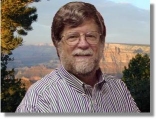 Chaz Cone
Ham Radio and me in the '70s2 Meter FMThe '70s brought about the growth of VHF communications. The 2-Meter band, which had always been there, was "rediscovered" when Ham Radio transceivers came along using FM on 2-meters.The radios were very small (and eventually were hand-held) and worked for short distances (a couple of miles depending on terrain). They were chiefly meant for mobile communications among local hams. I got my first one, a Regency HR-2B:
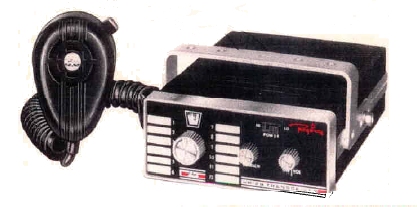
FM signals took more bandwidth than CW and SSB and, conventionally, were channelized. Instead of a tuning knob you had a rotary switch that allowed you to switch among several channels. The thing that made this neat was that repeaters came along:
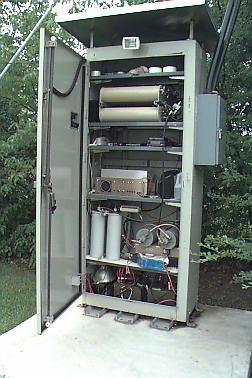
Repeaters were assembled, installed and owned by radio clubs and the frequency pairs were assigned word-of-mouth from community to community and published to the local hams. Since 2meter FM radios of the time were very limited in power (usually 10 watts or less), and since communications at the 2Meter frequency was short-range, we didn't need all that many repeater frequency-pairs since a repeater in Atlanta and another in Birmingham could use the same pair without interference. It was 'way cool to have car-to-car (and later, hand-to-hand) communications; there were a few rich people who had telephones in their cards but they were very expensive. The 2M FM radios of that day cost about $250. You connected them to 12VDC power in the car, stuck an antenna on top or on a fender or trunk or bumper and you had a great, static-free network of hams. This was especially valuable in emergencies. Then, someone had this great idea: Since repeaters were, by definition, installed somewhere where there was electrical power available, why not run a telephone line to the repeater site and interface it to the repeater? A ham using a mobile radio could send a code to the repeater causing it to connect the phone line and a touchtone pad:
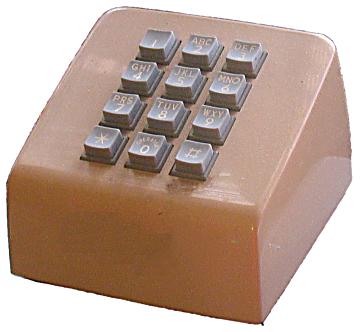
Wow! Talk about impressing your friends! This facilty was another form of a "phone patch"; the phone line was "patched" into the repeater transmitter and receiver. Compared to the type of phone patch we used from our home stations, this was fully automatic. There were a few eccentricities with the "phone-in-the-car" paradigm:
But it was supercool, regardless.
1971I was in regular radio contact with a missionary in Tegucigalpa, Honduras. His name was Harold Hurst (here's his QSL card):
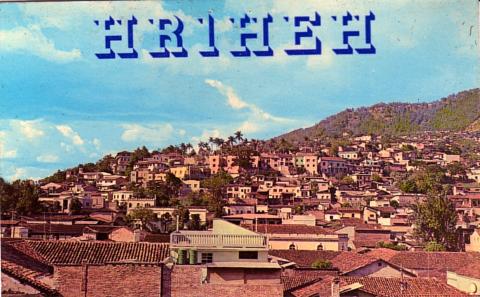 His mission was to attend to a remote indian tribe fifty miles out in the bush. These people were in sore need of medical and dental attention. I had "phone patched" Harold in to a physician in Atlanta several times as he was trying to arrange a medical mission to help his tribe. The Northside Drive Baptist Church here in Atlanta:
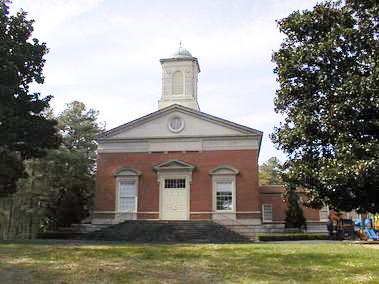
Another Atlanta ham, Dale Schwartz K4ROZ and I were asked if we could provide phone patches from Honduras to the the young people's parents here in Atlanta. We readily agreed. Since there was no electricity in the bush, Harold had a small generator he took along with his ham gear to keep in radio contact. Over the six week period, Dale and I handled the phone patches to the kids' folks here in Atlanta. Each youngster was able to talk home every three or four days and it really was great to give them that contact. The mission ended and we didn't hear any more about it for a few months. Then Gael and I received an invitation to a banquet and reception at the Governor's Mansion honoring the participants of the Honduras Medical Mission! I checked with Dale and he and Susan had received one as well. Wow! A banquet and reception at the Governor's Mansion. I guess the mission had friends in high places. It turns out that one of the young people on the mission was Chip Carter, son of Governor Jimmy Carter. Several of our phone patches were between Chip and Jimmy and Rosalynn Carter -- but we didn't recognize the phone number or voices. What a thing! The evening came and, dolled up to the nines, we arrived at the Mansion. We were met at the door by the Governor, Mrs. Carter and the Governors mother, Miss Lillian:
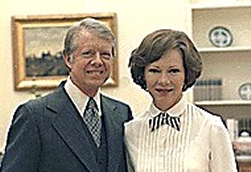 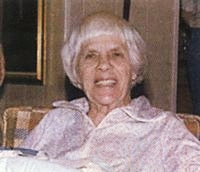
In due time we were ushered downstairs to the basement where there was a large meeting room. It was outfitted with a number of cafeteria tables with red and white checked paper tablecloths. The food service was another four or five tables laid out with potato salad, Cokes in bottles, potato chips -- and Spam. That's right; Spam sliced directly from the can (can't miss those oblong rectangles).

I whispered (I thought) to Gael, "It's obvious that the Carters aren't wasting state money on this event!". A voice from behind me said, "Yes, my Jimmy is very frugal." His mother, Miss Lillian. It was a pleasant evening for a worthwhile cause but when I drive by it, I never look at the Mansion the same way again after that night.
1972: The DXpeditionEven though 2M FM was cool and useful, my real interest in Ham Radio was always DX chasing. There was always something exciting about talking to another ham in a far-away land. The term "DX" means "distance" and generally refers to places far away. At this time there were about 325 different places in the world where Ham Radio was legal. Most of those places are "real" countries (like England, France, China) but, by the rules of the Ham Radio governing body in the US (American Radio Relay League) some places (called "entities") were counted as separate countries even when they weren't sovereign lands. So, for Ham Radio purposes, Puerto Rico, Alaska, Hawaii and other possessions of other sovereign countries also counted as "entities" for those pursuing awards.The most popular award for DX was the DXCC (DX Century Club). All you had to do was confirm contact with 100 countries (or entities) and you get this nice certificate. Then you could get endorsements when you worked more entities. One hundred entities is not that difficult but soon, after the easy ones are bagged, it becomes more difficult. The difficulty is compounded by the fact that some DXCC entities are uninhabited. That's right; they count if you can work 'em -- but nobody lives there. Not just no hams, no people. Because of this, from time-to-time, intrepid hams mount expeditions (called, naturally, DXpeditions) to these places, erect antennas, bring radios and provide contacts to the rest of the world from these entities. At a meeting of the Southeastern DX Club in Atlanta in November, 1971, I mentioned that I was going to put together a DXpedition to somewhere rare but reasonably close to Atlanta. There was some enthusiasm about the idea so I did the leg- and paperwork to mount a DXpedition to Navassa Island:
 The arrow points to our landing point.
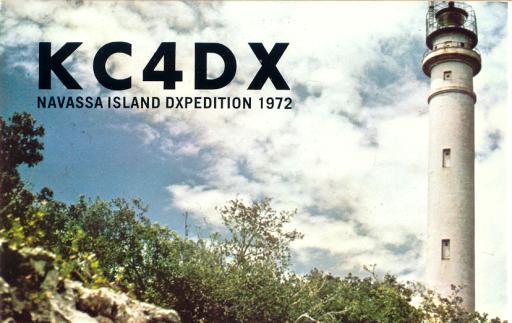
We made our way by boat from Jamaica to Navassa and back. When we returned to Jamaica we were met at the dock in Kingston by the families of two of our DXpedition members. Ray Cobb's wife, B.A, was there along with my wife Gael and our 11-month-old daughter, Kristen (she changed the spelling of her name when she was thirteen to "Kristyn" and that's the way it is today.) The Cobbs and Cones had arranged to rent a cottage in Ocho Rios (on Jamaica's north shore) for a week to unwind after Navassa. The cottage was named "Hamilton Cottage" and we rented it from "Lord Ronald Graham Realty". It was a pretty good trek from Kingston to Ocho Rios and I'm sure we did it by car but my memory is faulty here. All the radio gear was packed up to go back to the states so we didn't have any Ham Radio activity from the cottage. Hamilton Cottage came with a staff or three: cook, housekeeper and gardner/guard. It had three bedrooms and a saltwater swimming pool. The cottage was located on a cliff overlooking the Caribbean; very, very nice. During our week there, Ray managed to meet Dr. John Manley who was related to Jamaica's prime minister. Dr. Manley was a ham and bemoaned the fact that he couldn't get a decent (or any) antenna into the country easily without massive duty (despite his relationship to the Prime Minister). We stored that information away (it will be come important soon..) Anyhow, we had a great time and returned home a week later tanned, rested and full of good stories about the DXpedition and our vacation in Ocho Rios. Oh, we didn't bring many toys for Kristen to play with; she found a Red Stripe beer bottle, though, and was a very happy li'l camper:
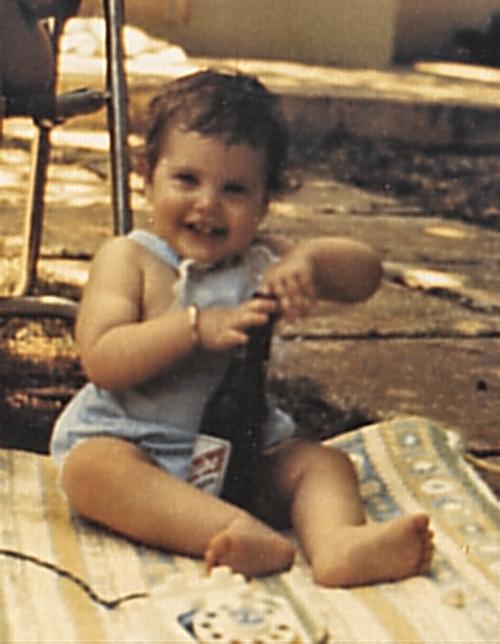 1973We had such a good time in Ocho Rios that next year we convinced another (non-ham) couple to go back to Hamilton Cottage with us. This time we'd leave Kristen at home with her grandparents but would take a radio with us so I could operate W4GKF/6Y5 from Ocho Rios. The "/6Y5" appended to my callsign is the callsign prefix for Jamaica and was how reciprocal licensing worked in those days. Jamaica gave permission for me to operate as W4GKF/6Y5.I had acquired a transceiver by that time, the Yaesu FTDX-570:
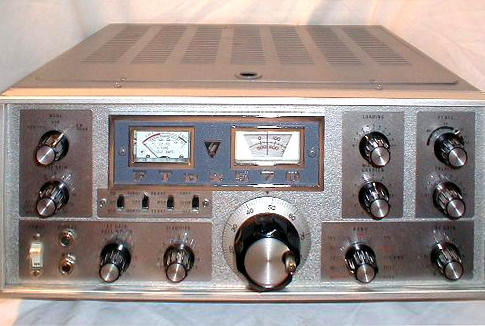
Gael and our friends, Pete and Maryanne Butler were happy to indulge my hobby but insisted I take the noise out by the pool. No problem! To get "on the air" you need power (happily supplied by Hamilton Cottage), a radio (the Yaesu) and an antenna. Since this was a temporary situation, the antenna had to be portable and easily erected. And it would be nice if the antenna were capable of multi-band operation. I chose the Hustler 4BTV vertical antenna to bring along: 
The antenna only weighed 15 lbs and was 21' high when assembled. It had the virtue of allowing me to work four bands: 10 meters, 15 meters, 20 meters and 40 meters. We'd used one just like it on Navassa and it performed well there. With Pete's help I got the antenna assembled (duct-taped to a stump) out next to the edge of the cliff. We ran the feedline over to the edge of the pool (about 40') and set up on a pair of lawn chairs. We ran an extension cord from the house and I was on the air as W4GKF/6Y5!
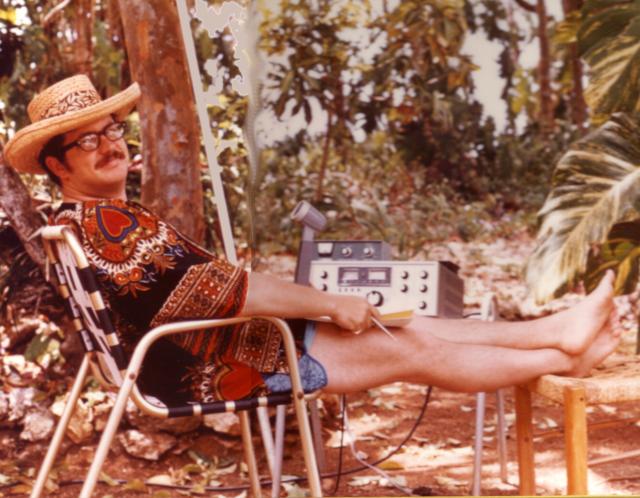
Near the end of our week-long stay in Hamilton Cottage, we arranged to have Dr. Manley and his wife join us for dinner at an excellent Italian restaurant at a resort called "Sans Souci" (French for "without care"). We were given a table in the large dining room with louvered shutters raised and a lovely view all around. About halfway through the main course, I noticed Pete's fork was lifted about halfway to his mouth - and he was frozen in that position. He said, "Omigawd! Isn't that (movie star) Ali MacGraw coming into the room?!?" I looked where he was looking and said, "I think so -- because that's Steve McQueen and Dustin Hoffman right behind her!" Turns out McQueen and Hoffman were in Jamaica filming "Papillon" and the entire cast and film crew were having dinner at Sans Souci that evening. The Manleys had no idea who the stars were so we filled them in. Steve and Ali were the "hot couple" in the States at that time. Dustin Hoffman and his party (mostly grips and other crew members) were seated next to us and Gael (who admires his work greatly) had a great "adjacent-table" conversation with him. Pretty heady stuff for us and, yes, I know it's not Ham Radio-related but I love to tell the story. After dinner, Dr. Manley "found" the 4BTV and the vacation ended well for all of us.
1974The next Ham Radio adventure worth relating happened back in Atlanta. We had enclosed our garage just before Kristyn was born and I had a tiny hamshack built into a closet in the new room in our house on Windsor Parkway. I had a Mosley Classic 33 tri-band antenna:
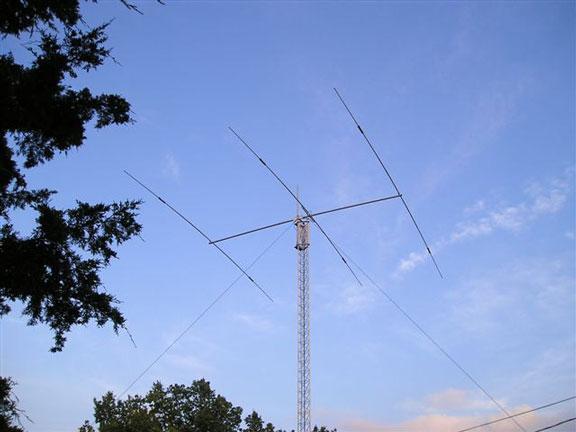
Worked pretty well. Here's a picture of my hamshack with IBM buddy and Navassa DXpedition member Bill Donovan WB4WMG sitting at the rig:
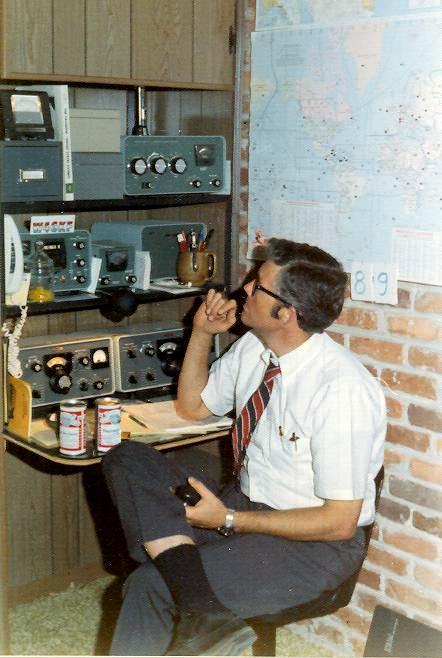 Ignore, please the two cans of Bud; dunno how they got in the picture..
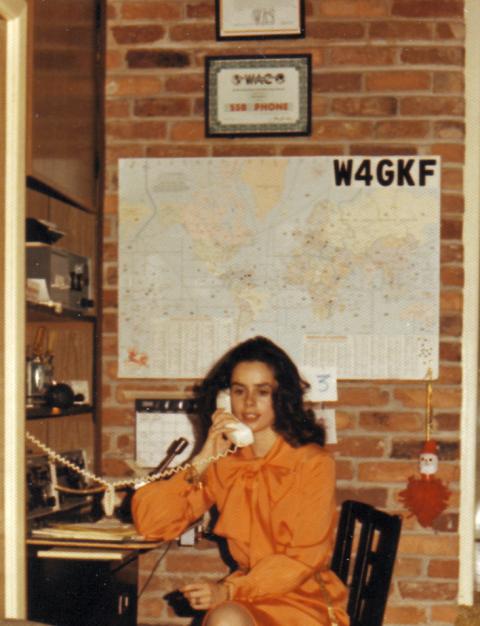

Wow! Here I am in Atlanta, Georgia. She's in the South Pacific. What to do?!? I telephoned the Naval Air Station in Marietta, GA and got through to a communications officer there and explained the situation. He contacted the Air/Sea Rescue base in San Diego and they came up on frequency. But the nature of radio signals is that they "skip", bouncing off the ionosphere. In this case I could hear San Diego and I could hear the lady on the boat but they couldn't hear each other. I relayed messages from the Navy in San Diego to the lady. She reported that they were two days out from Tahiti and was able to give their coordinates. The Navy told me that they were in French-controlled waters and their best chance of rescue was to contact the French Navy in Tahiti. The Navy tried to do that but, since the couple in danger were only Americans, the French Navy was disinterested in helping (what a surprise..) About that time, another ham on another boat who had been listening broke in. He said he was 6-10 hours away from the distressed boat and would begin steaming in their direction to see if he could pull them away from the island. He suggested in the meantime that I tell them to put out a "sea anchor" to help drag them away from the island. I relayed all that since the new benefactor was too close to the distressed boat to be heard. About that time, another ham in Hawaii who'd been listening to all this announced that he was hearing everyone. By then, the skip had changed so that I wasn't able to hear the distressed boat all that well. We decided to turn the incident over to the chap in Hawaii to continue communications since I was losing them. I stayed on frequency for another hour or so but wasn't able to do much to help. Eventually I went to bed without finding out what happened. Nearly a year later I received a letter from the couple aboard the "Chanson". The other boat reached them and helped rig the sea anchor and they never were driven aground. They were very appreciative of everone's help and sent me a photo of the "Chanson". I've misplaced the letter and the photo but when/if I find them I'll include them here. It felt great knowing that Ham Radio had come through again!
1974-1975In 1974 we built a new home in Marietta, GA and I decided to upgrade the station (a lot). I put up a 90' Rohn 25 tower, guyed three times and retired the Mosley tri-bander. In it's stead, I put up three multi-element monobanders, one each for 10 meters, 15 meters and 20 meters. I had four elements on each band looking like a Christmas Tree. The antenna work was done my my good friend and Ham Radio buddy, Dave Johnson (then WA4SSU, now K4SSU). Dave is the best tower/antenna man in the world; that's not just my opinion - it's shared by scores of hams in Georgia.It was during the installation of all that (tower and antennae) that I met Jim Whitmire who was to become my great friend and business partner in multiple endeavors now for more than thirty years. Jim became licensed as KD4M and I've been working for several years now to get him back on the air! With this tower, these antennae and the S-Line, I felt I had an extremely competitive ham station. I built a very nice hamshack in the basement and made a lot of contacts over the next three years. One day, my friend Winston Whitlock WA4PBW was over for a visit and was listening while I called "CQ". A station came back and said, "Chaz, how are you doing?" I replied, "Quite well, your Majesty." Winston's eyes popped; "Who is that!?" I told him, "It's King Hussein of Jordan (of course)". He flipped out at the idea that I was speaking to the King of Jordan and apparently had done so before. I offered Winston the microphone but he demurred. Some years later, Winston met and spent time with King Hussein's son, the Prince, so he's one up on me! But I have the card:
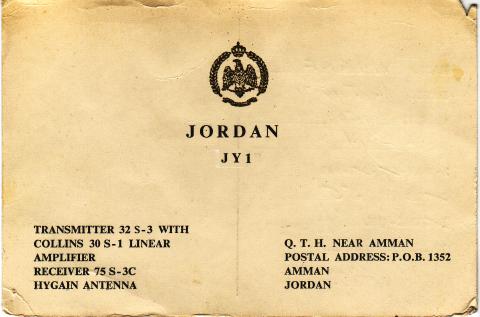
"BDL-OMP, BDL-OMP, BDL-OMP, KA-BOOM!" Gael said, "What in the world was that!?!" I said, "Sounds like a large insulator banging its way across the roof.." And, it was. I ran out to the driveway and there was my 90' tower and my three monoband antennas crumpled like a dead spider in the vacant (thank goodness!) lot next door. The tower had broken over at the 30' level and made a nice bridge over the top of a..
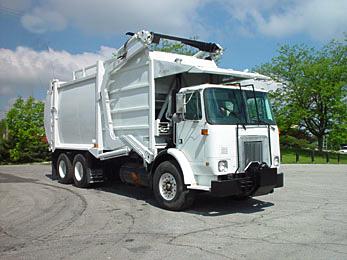 It seems that the garbage truck, which had been up and down our driveway scores of times, this time had hooked the guy wires attached to a 12' steel post at the side of the driveway and, feeling nothing as he kept coming up the driveway, -- dragged the guy wires with him, pulling the tower over. The noise we heard in the kitchen was the egg insulators on the guy attached to the top of the house pulling free and bouncing across the roof.
Reading back over those very long sentences, I don't know another way to explain it. It looked like this: 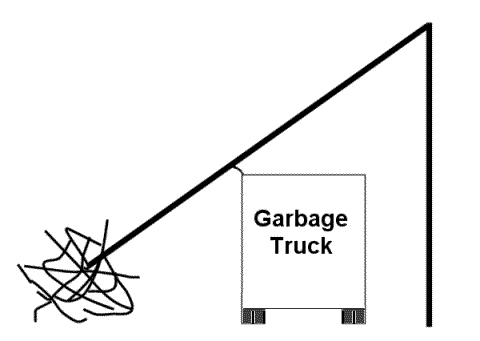
1977Though not directly related to Ham Radio, at the end of 1977 Radio Shack introduced their first personal computer, the TRS-80. I'd always been a programmer at heart, though my working day was in sales/marketing at IBM. I was the first on my block to buy one of these $600 gems and was soon writing programs in Basic. Among my first attempts was a logging program for Ham Radio.Soon thereafter, a ham buddy, Ron Lorber WB4WMK asked me if I thought a desktop computer could ever be useful in an office environment. He was an orthodontist (you know, those guys who straighten teeth) and wondered if something could be written to help him in his office. I looked upon this as a challenge; what's the good of having your own computer if you didn't have a "never been done before" project? So Jim Whitmire (you met Jim, KD4M a few paragraphs back) and I decided, as a lark, to try to write something for Ron. We began the project and tinkered around with it for the rest of the decade.
1978-1979After only about three years in the new house my employer, IBM, in its infinite wisdom, decided my career required that we move from Atlanta to Boca Raton, Florida. It was a great opportunity and my first management billet -- so we went. Goodbye to the 90' tower and stacked monoband antennas, hello to 30' and the old Classic 33.The Boca house had a guest house and that's where the hamshack went. I confess I wasn't too active during this period as the new job consumed just about all my time. And, there was the drug dealer (also a ham) next door -- but that's another story. The project in Boca Raton was to build a small business computer to compete with Apple and Radio Shack. The product was to be called the "System/23 IBM Datamaster":
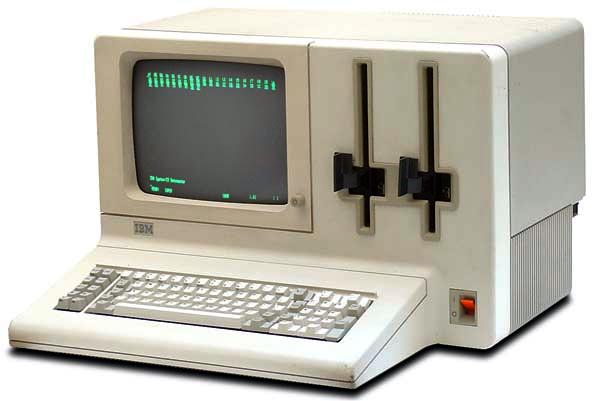
Fortunately, just as the '70s were ending, we were transferred back to Atlanta (Yay!) Read on for my '80s Ham Radio experiences..
|